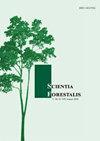巴西本土树种的嫁接效率
IF 0.4
4区 农林科学
Q4 FORESTRY
引用次数: 0
摘要
嫁接无性繁殖已被广泛应用于多年生植物的早花早结实。本研究旨在评价巴西7种本土树种:蓝花楹(Jacaranda mimosifolia)、Handroanthus heptaphyllus、大叶甜菊(sweetenia macrophylla)、三叶草(Schinus terebinthifolius)、红雀(Cariniana estrellensis)、红雀(Poincianella pluviosa)和黄膜菊(Hymenaea courbaril)的嫁接效率。该实验于2018年1月至4月进行。在移植后50和90天测定嫁接成活率、茎数、长度和周长。数据进行方差分析(ANOVA),然后进行Tukey检验。移植物存活率在不同物种间差异显著。其中,含羞虫、七叶虫、三叶虫和巨叶虫存活率最高。芽长和周长分别高于绿皮冬和大叶冬。三叶草(S. terebinthifolius)和绿皮草(C. estrellensis)的芽数最高,两者之间没有差异。这些结果表明,接穗/砧木的附着、愈伤组织的形成和维管组织的发育是成功的。所研究树种的嫁接无性繁殖是有效的,在基因型修复和杂交方面具有良好的前景。本文章由计算机程序翻译,如有差异,请以英文原文为准。
Grafting efficiency in Brazilian native tree species
Vegetative propagation by grafting has been widely used to induce early flowering and fruiting in perennials. This study aimed to evaluate the grafting efficiency of seven native tree species in Brazil: Jacaranda mimosifolia, Handroanthus heptaphyllus, Swietenia macrophylla, Schinus terebinthifolius, Cariniana estrellensis, Poincianella pluviosa, and Hymenaea courbaril. The experiment was conducted from January to April 2018. Graft survival, shoot number, length, and circumference were determined at 50 and 90 days after grafting. Data were subjected to analysis of variance (ANOVA) followed by Tukey’s test. Graft survival differed significantly between species. The highest survival rates were observed for J. mimosifolia, H. heptaphyllus, S. terebinthifolius, and S. macrophylla. Shoot length and circumference were higher in C. estrellensis and S. macrophylla, respectively. S. terebinthifolius and C. estrellensis had the highest shoot number, not differing from each other. These results indicate that the processes of scion/rootstock attachment, callus formation, and vascular tissue development were successful. Vegetative propagation of the studied tree species via grafting is effective and has good prospects for genotypes’ rescuing of and for hybridization.
求助全文
通过发布文献求助,成功后即可免费获取论文全文。
去求助
来源期刊

Scientia Forestalis
Agricultural and Biological Sciences-Forestry
CiteScore
1.00
自引率
0.00%
发文量
39
期刊介绍:
Scientia Forestalis is a scientific publication of the IPEF – Institute of Forest Research and Studies, founded in 1968, as a nonprofit institution, in agreement with the LCF – Department of Forest Sciences of the ESALQ – Luiz de Queiroz College of Agriculture of the USP – São Paulo University. Scientia Forestalis, affiliated to the ABEC – Brazilian Association of Scientific Publishers, publishes four issues per year of original papers related to the several fields of the Forest Sciences.
The Editorial Board is composed by the Editor, the Scientific Editors (evaluating the manuscript), and the Associated Editors (helping on the decision of acceptation or not of the manuscript, analyzed by the Peer-Reviewers.
 求助内容:
求助内容: 应助结果提醒方式:
应助结果提醒方式:


